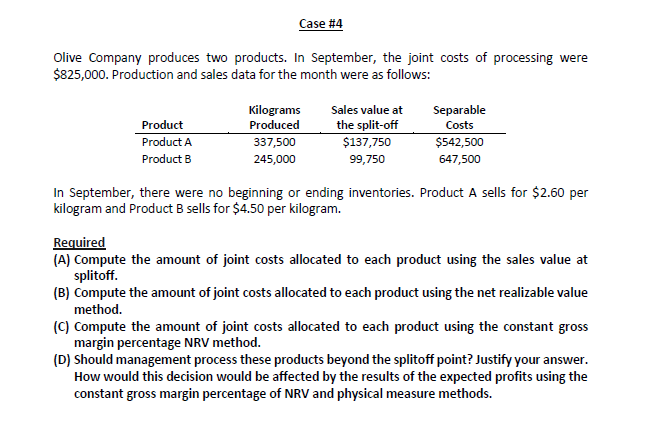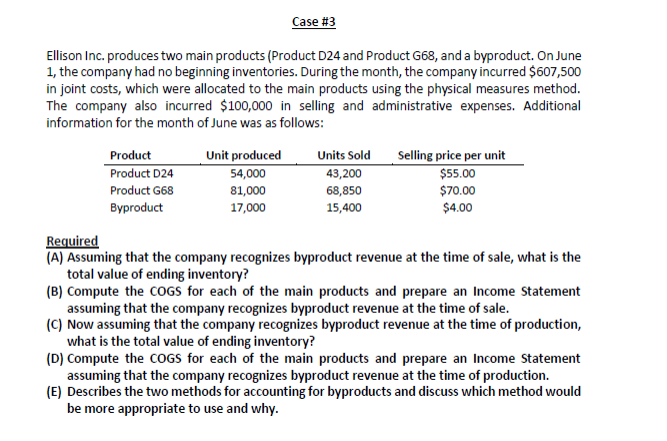

Olive Company produces two products. In September, the joint costs of processing were $825,000. Production and sales data for the month were as follows: In September, there were no beginning or ending inventories. Product A sells for $2.60 per kilogram and Product B sells for $4.50 per kilogram. Required (A) Compute the amount of joint costs allocated to each product using the sales value at splitoff. (B) Compute the amount of joint costs allocated to each product using the net realizable value method. (C) Compute the amount of joint costs allocated to each product using the constant gross margin percentage NRV method. (D) Should management process these products beyond the splitoff point? Justify your answer. How would this decision would be affected by the results of the expected profits using the constant gross margin percentage of NRV and physical measure methods. Ellison Inc. produces two main products (Product D24 and Product G68, and a byproduct. On June 1 , the company had no beginning inventories. During the month, the company incurred $607,500 in joint costs, which were allocated to the main products using the physical measures method. The company also incurred $100,000 in selling and administrative expenses. Additional information for the month of June was as follows: Required (A) Assuming that the company recognizes byproduct revenue at the time of sale, what is the total value of ending inventory? (B) Compute the COGS for each of the main products and prepare an Income Statement assuming that the company recognizes byproduct revenue at the time of sale. (C) Now assuming that the company recognizes byproduct revenue at the time of production, what is the total value of ending inventory? (D) Compute the COGS for each of the main products and prepare an Income Statement assuming that the company recognizes byproduct revenue at the time of production. (E) Describes the two methods for accounting for byproducts and discuss which method would be more appropriate to use and why. Olive Company produces two products. In September, the joint costs of processing were $825,000. Production and sales data for the month were as follows: In September, there were no beginning or ending inventories. Product A sells for $2.60 per kilogram and Product B sells for $4.50 per kilogram. Required (A) Compute the amount of joint costs allocated to each product using the sales value at splitoff. (B) Compute the amount of joint costs allocated to each product using the net realizable value method. (C) Compute the amount of joint costs allocated to each product using the constant gross margin percentage NRV method. (D) Should management process these products beyond the splitoff point? Justify your answer. How would this decision would be affected by the results of the expected profits using the constant gross margin percentage of NRV and physical measure methods. Ellison Inc. produces two main products (Product D24 and Product G68, and a byproduct. On June 1 , the company had no beginning inventories. During the month, the company incurred $607,500 in joint costs, which were allocated to the main products using the physical measures method. The company also incurred $100,000 in selling and administrative expenses. Additional information for the month of June was as follows: Required (A) Assuming that the company recognizes byproduct revenue at the time of sale, what is the total value of ending inventory? (B) Compute the COGS for each of the main products and prepare an Income Statement assuming that the company recognizes byproduct revenue at the time of sale. (C) Now assuming that the company recognizes byproduct revenue at the time of production, what is the total value of ending inventory? (D) Compute the COGS for each of the main products and prepare an Income Statement assuming that the company recognizes byproduct revenue at the time of production. (E) Describes the two methods for accounting for byproducts and discuss which method would be more appropriate to use and why








